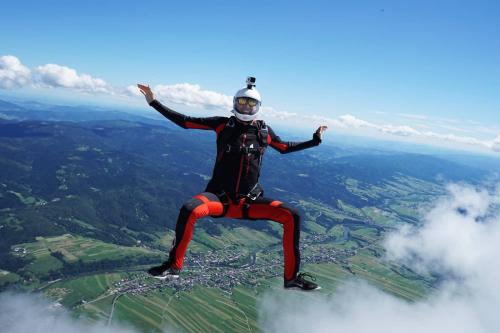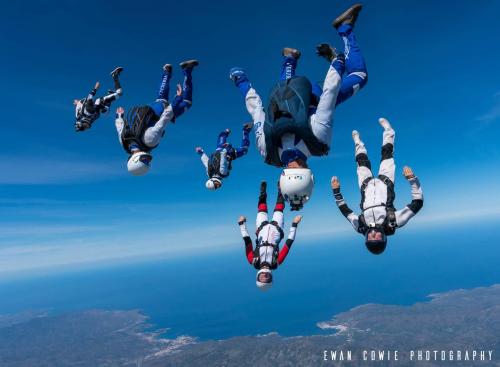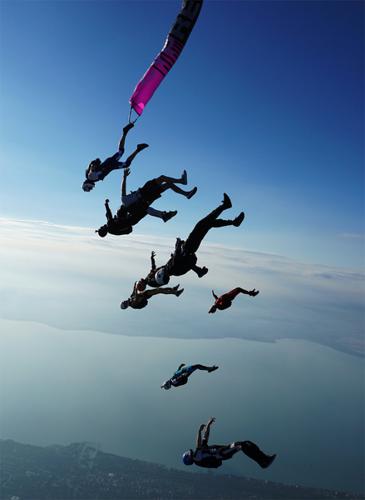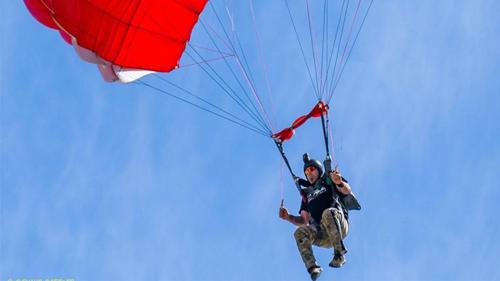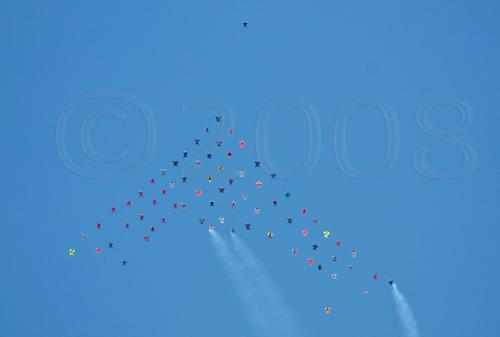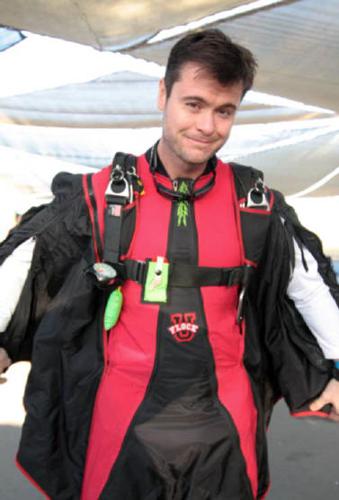Remember when you were a student? Most of us couldn't exit a plane to save our lives (or pass a level), the skydive seemed so short yet so full of things to do, and when it was over we had this nagging feeling of, "If only there was more time!" Welcome to 10-way.
If you're an accomplished competition formation skydiver, then 10-way isn't so tough, just another engineering challenge to meet with a little thought and practice. But for most weekend warriors who usually just jump with their buddies to have fun, funneling exits with varying frequency but not quite sure why, 10-way is an event that makes you feel like a student again. But when you start training for 10-way, like when you were a student, a new world of skydiving challenges opens up to you.
Not only is it challenging--10-way is also a blast! It's some of the most intense skydiving you'll do, because whatever you do, it's got to be very fast if you're going to be competitive. And you don't have to be a full time skydiver to get good at it. As Roger Nelson, program manager at Skydive Chicago and eight-time 10-way medalist, often said, "10-way is the only discipline at Nationals where you can be a weekend warrior and really compete against the best in the world." For example, Skydive Chicago's STL10 team practiced in the mornings from 7 a.m. to 10 or 11 a.m., stopping to allow jumpmasters and videographers to work for the rest of the day, and still won two gold and two silver medals in four competition years.
And who knows how low the time can go? "We're building 9.2-second jumps, thinking we're pretty hot, but Roger's saying, 'I think we can do eights…' and we did," remembers Frank Shisler, member of Skydive Chicago STL10 in 2000 and 2002. "It's all about focus and intensity; once you step in your slot behind that line, it's a totally different world." When you're really training for 10-way, you give that exit and skydive every last bit of effort you've got. To excel in 10-way, that's what it takes.
If you just want to play with this new discipline for fun, well, it lends itself to that too. Not being a World Meet event, it tends to be more casual and the experienced teams more supportive than in some other events.
This article presents the lessons learned from several years of 10-way experience with a recognized top 10-way team, Skydive Chicago STL10. The concepts explained here are valuable to anyone working on 10-way, and will be most useful for those trying to get past good on their way to great.
Your Mission Is…
Your goal for every 10-way formation skydive is to build one correct predetermined formation as fast as possible. There's only one point to remember. In theory, it's the simplest competitive skydiving event out there, with the exception of accuracy--get to the right place as fast as you possibly can (or at least faster than the next team). It's almost a drag race between teams, especially in the later rounds.
Easy, you say? Not necessarily. To be sure, the "new" rules (which went into effect for the 2002 Nationals and were a screaming success) make things a bit easier than they have been in previous years because they now allow grips out the door. This means that you can launch part or all of the 10-way as a chunk, thus making the exit frame (the position of everyone when the last person exits the door) tighter. Then the early floaters and late divers don't have as far to go to the two unlinked jumpers who form the base, making the completion time shorter.
The rules require the first two jumpers in the base to be unlinked, which can happen with a grip flash after launching a chunk. So technically, you could launch all 10 together, let go of the base two, then dock the two four-ways on the base if you could manage it.
By the way, all participants except the camera flyer must be lined up behind a line on the floor for exit--no floaters allowed. This line goes from the forward edge of an Otter door to the rear bulkhead on the right side of the plane. Going over this line starts the clock, even if you are obviously just setting up and not ready to exit, so be careful of it until you are ready to exit.
You have 35 seconds to build the formation in competition, because a five-second hold time is required within the total working time of 40 seconds. If you take longer than 35 seconds to build the formation, it's a bust and you are awarded the full time of 40 seconds.
Why 10-Way?
So what exactly will 10-way do for you? It's not a World Meet event. It won't teach you transitions and vertical hops. You can't practice it in the wind tunnel. But it will teach you all about exit dynamics, subterminal relative work, approaching a formation from above or below, and a respect for team cooperation at least equal to that you get from other disciplines.
Body position on exit is just the beginning. Since there are no outside floaters in 10-way, the way your body is positioned upon breaking the plane of the door (while driving out the door hard) determines how far you (and anyone behind you) will be from the teammates ahead of you. What you do in that split second determines the outcome of your skydive. Contrary to popular belief, 10-way is not all about diving. The first few people out are dive floaters--they bomb the door, but do so either sideways (with their left sides exiting first) or turning to the right (exiting a Twin Otter) in order to float back up to the base. Between dive floating, setting a base, and diving down to the base, there is a wide range of ideal exit body positions based on the slot in question, and every member of a good team has an understanding of all of them.
On to subterminal work. When 4-, 8-, and 16-way competitors say the exit is everything, they generally mean that the exit separates the best from the really good. In 10-way, the exit is almost literally everything. From the instant you cross that line inside the plane to the instant the last grip closes is your build time. Just to give you a little perspective, SDC STL 10 averaged a build time of 9.79 seconds for the required six rounds in the 2002 USPA Nationals (which they won). If we assume that we spend 8 seconds "on the hill" before reaching terminal velocity, and that a fast exit might hit 2 seconds on a really good day, that means that a top 10-way dive is completed before hitting terminal velocity. That's what we mean when we say the exit is everything--building a formation that fast requires an ideal exit and a lot of flying skill on the hill.
Once you're out, if you're not the base, you have to dock on it. Since we're talking about sub-terminal hill work, we have to remember that the plane of the formation is still tilted to some degree relative to the ground. Thus, the floaters approach from below and the divers approach from above--which is quite different from the typical larger-formation picture of approaching on level. Here, level is relative to the plane of the formation, not the horizon. And if you want fast times, you don't have time to hit level a distance out from the formation and approach flat. You need the fastest approach, which is a straight line. Besides, if you're building in sub-terminal air, the base is accelerating--so if you pause a ways out, you're usually hosed.
Cooperation and consistency among all team members is essential to each member's successful performance and thus that of the team as a whole, perhaps even more so in 10-way than in other competitive disciplines. All it takes is one sidestep by one person early in the lineup to hose the whole skydive by giving everyone else an exit they didn't expect (perhaps even involving the infamous door strikes). In a 35- or 50-second skydive, a bump on exit is much smaller in the grand scheme of things. But if your build time goal is less than one-third the working time of a 4-way jump, every fraction of a second counts. That's why every member of a 10-way team has to be on the same word, not just the same page, in order to succeed.
"You change one person, you change the whole thing," says Shisler. "If you want to be competitive, you have to put in the practice with the same people in the same slots."
Also, the cohesiveness and discipline you learn with 10-way will benefit you in any other competitive disciplines you choose.
You get all of these benefits from doing competitive 10-way, and you get to have fun too! The fun and bonding between team members are the biggest reasons why several teams, like SDC STL, compete together with minimal lineup changes year after year.
Exit Challenges
Diving out of a plane solo isn't so tough, but if you want to be in the same time zone as your teammates when you exit for 10-way, some grips are quite helpful. So now you're diving out some number of people as a chunk. That doesn't mean that you have to hold onto them forever--the people just behind the base and the divers behind them generally find that holding on just long enough to ensure proximity through the "snap" on exit is all they need (floaters tend to do best without grips, as dive floating individually is enough work).
Thus, if you are one of the jumpers with a grip on exit, your hold time and release timing will be engineered through trial and error, and consistency is an absolute requirement. Letting go of only one hand earlier than usual will spin the person you're holding. Letting go of both hands early will leave you and everyone behind you too far away (or the floaters too far away, if you are early in the lineup). Letting go too late might screw up the person you're holding.
Setting up behind the line is a lot like The Price is Right--you want to be as close as possible without going over. As stated earlier, this starts the clock whether the offending body part is a foot over the line or a head leaning over it. Think of the line as a plane, not just a line on the floor.
Your exit setup will go through a lot of changes before it settles into one that is good for everyone. Practicing on the ground with rigs is a helpful start, but the actual skydives are the real test. Once you've settled on an effective lineup (Jane's foot here, Bill's knee tucked in just so), stick to it unless you're trying to improve something and you let your teammates know. As previously stated, your exit affects everyone else's--so if you're going to change something, talk about it.
Movement on exit is another challenge--not everyone can move at the same time. If you're first out and start the clock, be sure that you go at the same point in the count, not leading the GO! one time and going right on it the next. This helps set the timing for the later divers, who have to be leaning in the right direction at the right time to exit with the team without either running people over or getting caught napping and being dragged out the door.
"You're skydiving from the word 'HOT!' " says Shisler. "A lot of casual teams get out (of the plane), get stable, then get together. You can't do competitive 10-way that way. You have to be flying together from the word HOT! A lot of people don't understand that."
Also, using the door side of the plane for balance is not allowed under the rules, whether during setup or on exit, though you can use the opposite side. (Note: if you lean on that side of the plane, be sure that no part of your rig is caught on a bench or seat belt bolt. I can tell you from experience that this definitely hampers your exit…) Your balance, which is essential to a good exit, depends on your agility, your teammates' balance, and a smooth jump run.
Speaking of jump runs, consistent airspeed as well as a smooth flight is essential. When traveling to different drop zones, or even with different pilots at home, we found that changes in airspeed produced noticeable changes in the exit frame. With higher airspeeds, everyone is more separated and the times are longer. With a slower airspeed, everyone notices a steeper exit frame and often a longer build time because of the different angle, despite being closer together. So, basing practice flights on the airspeeds specified in the competition manual (85-95 knots) is a big help to a seriously training team.
If jumprun is bumpy, your exit will stink. It's guaranteed. Don't be afraid to call a breakdown of the lineup and a go-around if the floor is rocking and rolling, especially in competition.
Formation Build Challenges
So now that you're out the door, for most of you it's time to chase the base. You might be tracking uphill with everything you've got, or diving and hoping you can stop without sacrificing a teammate. Either way, aiming for a target when both you and it are on the hill can be tough.
If you are building a 10-way quickly, in subterminal air, it's a big game of acceleration control--not position control. If you're the base, you try to keep acceleration constant. If you're a floater, you are trying to slow your acceleration and then match the acceleration of the base. If you're a diver, you're accelerating more and then trying to slow--not stop--your acceleration to match that of the base. Matching position with a stationary target isn't so bad, but the acceleration game is a challenge.
Add to that the fact that you are working in "mushy" subterminal air, and the degree of difficulty rises again. It's a lot harder to make these acceleration changes at this time than it would be in terminal freefall, especially right out the door. Respect the fact that things just don't work quite as well as you want if you're not used to a lot of subterminal maneuvering, and take it easy the first several times. Hitting the base hard can take it out, or it might just change its angle enough to make it cut into or surf on the relative wind more than it was doing before you hit it. This will change the base's position from its normal exit frame, hosing the floaters and divers who haven't docked yet. With a highly practiced team, everyone gets accustomed to a certain exit frame after a certain amount of practice and is already going to that familiar spot on exit rather than waiting to see what the base does. When that spot changes, it messes up things for everyone.
Of course, at some point everyone has to cross the line in order to figure out just where it is…the takeouts can be spectacular.
Your vertical approach isn't the only thing that requires a lot of care--you don't want to hit the formation hard on the horizontal plane either. It's essential that the angle of the formation remain the same, ideally where it was planned to be. Large changes in the angle during the build screw up the approaches of everyone who isn't yet docked. When you're approaching the formation on the ragged edge of too fast to stop, it's pretty tough to adjust to an angle change.
Then, although it's best not to throw off the angle in the first place, it's not necessarily good to quickly fix it either. When time is short and the angle is off, those still approaching are already adjusting their approaches to compensate for the problem. If the base puts the angle back where it was, then those still approaching could be going the wrong way--to the temporary "bad" angle they saw just a second ago. Figuring out how much angle change your team can handle takes a lot of practice and awareness in the base and late floaters/early divers.
Last, but certainly not least, of the formation build challenges is that of grips. It's easy to snag the first bit of the right arm or leg that comes near you, but it's absolutely vital that you get a solid grip the first time, not just grabbing a fold of a jumpsuit and hoping it will hold. There can be a lot of tension in a fast 10-way build, and you'll surely get a lot of grief if you're the one who lets go.
Another thing about grips--if you are on the front of the triple diamond, you have no grips. However, if you keep your hands out wide and overlap the hands of the person next to you, it can look like you do--this will look like an incorrect formation. As in the smaller-way RW disciplines, you have to present the formation to the judges correctly in order to get scored. Each slot carries the responsibility for this.
Slot Specifics
First of all, the exit is roughly a single file line. Many teams will stack the first couple of people out the door or curve the lineup to shorten its overall length from the door, but the later divers tend to do best when exiting single file so they don't interfere with each other during side-by-side exits. The early slots (usually 1-3 or 4) are the floaters, the middle slots (usually 4 or 5-6) are the base, and the last to exit (usually 7-10) are the divers.
Floaters--For decades, late divers have had the "glory slots" on larger formations because all eyes were on them as the formation completed. In 10-way, the ideal situation is for the last floater and the last diver to dock at the same time, so there's a lot of healthy competition between the two groups.
"If you don't get out of the plane in a mode that propels you up, then you're behind the curve and the divers beat you every time," says Ron Olson, four-time 10-way medalist in slots 1 and 2. "You've got to know where your target is--the sooner you spot it and the angle it's coming at you, the quicker you can adjust to where you need to go. You need to be able to cup air and look where you're going at the same time, and go where you look. You're pointing your toes and driving at it hard, then all of a sudden you're level with it, it's coming at you, and you're trying like crazy to stop.
"The rest of it is looking at the divers and knowing that if you slack off, they'll beat you there," he laughs.
With a quick build, floaters certainly have to work hard. First they're anchoring in the airplane to stay behind the line even though others might be leaning on them, then they're going up as hard as they can go, then they're stopping as hard as they can and punching out a hard arch to stay with the base as it continues to accelerate. No 10-way slot is for tentative flyers, but the floater slots in particular are best filled by skydivers who know how to get maximum performance out of their bodies--whether it's tracking up hard, slamming on the brakes with your knees almost in your chest, or backsliding in your slot to keep up with the formation sliding down the hill.
And like divers who need to go fast and stop quickly, floaters benefit from a lighter body type. "Lighter people have a better chance of recovering when they're behind the curve," Olson notes. However, you have to be able to match the base's fall rate when you dock, so if you are so light that you can get to the formation quickly but not stay down with it, you might need weights even if you are a floater.
Another key to a good floater performance is a consistent base, says Paul Wold, four-time 10-way medalist in slots 2 and 3. "You've got to leave the plane going to your slot on the base, or you're too slow. But you can't leave the plane going to a spot like that unless the base is in the same place every time."
Base--Just in case you haven't heard the word "consistent" enough yet, "consistent" is the hallmark of jumpers suited for these two slots. The 10-way is "initiated by two unlinked jumpers"--that's you. Your job is to get out of the plane the same way and speed every time, and to set a stable fall rate every time and a stable heading for each formation.
It sounds like a job for a drop-test dummy, but it isn't. On exit, you might have two or three people hanging on you, so not only are you towing them out as you start the "train," you also get to deal with any of their issues as well as your own. It's your job to fix any problems that arise so that you exit where and as fast as you are supposed to be. Regarding the formation build, as anyone who's done larger formations will tell you, sometimes you have to fight like hell just to stay still when other people are docking on you. And of course, all the effort you put into staying still includes vertical and horizontal force, and it's tougher to fly hard in mushy sub terminal air.
Base flyers should ideally be skydivers with lots of subterminal maneuvering under their belts, not career-long late divers or super floaters. People who are used to a lot of contact and working towards multiple points (particularly with competition RW teams) tend to have the subterminal flying skill and solidity (sometimes described as "roots in the sky") that these slots really need.
Solidity means that when someone docks too hard, you can almost instantly adjust to minimize their effects on the rest of the formation. This requires split-second reactions and strong flying skill, the kind an instructor needs when manhandling a creative student. This slot isn't for "delicate" flyers who are easily bumped out of position. Also, the base can't be maxed out in terms of fall rate (slow or fast), because the adjustments could go either way (more on weights later).
Position isn't just related to fall rate and your spot in the sky, it also involves the right angle for everyone. You'll find that once you get your exit to be fairly consistent, everyone ends up in about the same place relative to each other in the exit frame. So you plan each formation's angle to give everyone the shortest approach to their slots. If the base doesn't set that ideal angle, then everyone has further to go and thus the time is slower. And as previously discussed, maintaining the angles throughout the build is also the job of the base and anyone who has already docked.
With practice, you develop an image of the exit frame you expect to see, and any significant changes then offer the option of accommodating them. If, for example, a floater flipped on exit and dropped down, you might punch it out a bit to help them out. But you don't want to go all the way to where they ended up, because then you make nine people work to save one. Ideally, you go to a point in between where everyone else goes a little further, and that floater goes a little further, and your time is better than if you went all the way to the floater and made the divers make up the entire distance.
Divers--Even experienced large-formation divers often get humbled when they switch to a good 10-way team, because much is the same, yet much is different. If you're building a fast 10-way, the divers can't go into a max no-lift dive at all because they'll blow right past the formation (this is the most common mistake). As stated earlier, this is a game of acceleration control, with emphasis on the control.
It starts with "not listening to the count, but feeling movement and being prepared," says TJ Hine, two-time silver and two-time gold medalist in 10-way with Skydive Chicago STL (TJ has been #9 for the last two years). "You've got to be skydiving from the word 'HOT!' " The right exit for a diver is one where he isn't getting pushed or pulled, instead flowing out the door smoothly behind his teammates with grips on the laterals to maintain proximity out the door.
Hitting the door is a concern for the later divers, but tends to start earlier in the lineup (such as when someone in the middle or an early diver cuts the corner to the right when exiting). Thus, the divers mainly rely on their teammates to put the train in the middle of the door so that everyone makes it out clean. Shin guards on the front of the shin or the outside of the calf can be quite helpful when working out lineups and exits early in the season.
Once you're out the door, "The big thing is how you release--you can push people around with the release, but don't hose your teammate," says TJ. "Figure out where the air throws you with your release and don't fight it. Design the formation from there, not from the lineup." For example, Skydive Chicago STL designed formations so that #9 was the last one in, not #10, because #10 (Tommy Shannon) always got thrown past TJ and to his right on the release, in a leapfrog type of move.
Next is the approach to the base. "The big thing is being aware of the base as fast as possible, not so much the person you're docking on," TJ explains. "Go for your airspace relative to the base." If you chase the person you dock on, then if they are out of place, so are you.
When slowing down to dock, you might find that swoop cords or baggier suits are quite helpful to a diver. As with floaters, leaner-bodied jumpers have a better time with diver slots; the floaters need to conserve altitude early, while the divers need to do so at the end of the approach to keep from passing the base.
Also, as with all slots, you have to hang on tight when you get there. "You need death grips on first grip," TJ adds. "The later guys can really put tension on the formation.
"The faster times are when people don't think, just react," he summarizes.
Weights and Swoops
It's well recognized in smaller-way RW disciplines that weights are necessary to equalize fall rates for various team members, and 10-way is no different. Whatever it takes to get all members to a matched mid-range fall rate, whether it's weights for one or a looser suit for another, then that's what should be done.
For example, as stated earlier, if you're a floater with a small build relative to your teammates, you might still need to wear weights in order to keep up when docking on and flying with the formation. The base might experiment with weights for a time, especially if all floaters or the divers are consistently faster to the base than the opposite group. Weights seem to have a significant effect on the base's initial acceleration out the door, which is what the floaters and divers evaluate for their target position. As previously stated, the fastest times are when the last floaters and divers dock at about the same time, so if one side has an advantage, you have to "handicap" them to get a better overall time.
As a diver, however, you probably don't want to wear weights unless absolutely necessary to match the formation's fall rate, as they decrease your ability to slow down your dive.
Regarding slowing the fall rate, remember that major changes in fall rate are the norm for non-base flyers in 10-way. Swoop cords are often used by divers to make the change from fast to slow easier, smoothing their docks. Swoops can be very handy for a diver who needs to stop hard, but make sure that they're not so tight that they restrict your movement. It's not good if they float you up in the formation or keep you from reaching your toggles comfortably.
Video
Last but certainly not least of the slots is your (hopefully) dedicated videographer. As SDC STL's 2000-2002 videographer and proprietor of Skycam Productions, Mike Wood, says, "If it's not on video, it never happened."
What's the most important thing about capturing a fast 10-way on film? "Don't screw up," Mike laughs. "I carried two cameras in competition just in case. There's absolutely no room for error. If a floater or diver goes low, they can fly back up and maybe get a worse score, but not having video gives you a 40 (the maximum score). You have to be there absolutely as quick as possible. If I'm one second behind, it costs the team. You have to be there before the last floaters and divers so you can see the last grip close on video to stop the clock.
"A lot of people don't take filming 10-way as serious as other disciplines because it's fun," he adds. "But it can be a very competitive thing just like 4-, 8-, and 16-way. It has its own challenges that make that one point very difficult to do fast, as well as filming that one point. With unpracticed teams, it might be 10 seconds before the first two people hook up. With us, it's over by then. There's no time to screw up and fix it. We're shaving tenths of seconds, not 5-10 seconds per jump. Even a 12-second jump is over very fast.
"To me, the biggest challenge is getting in your own little spot in the sky without hitting the floaters or the divers," Mike continues. "The exit is coming out so fast (with a medal-class 10-way) that you have to jump many times with the same people in order to learn to react to the base's colors. You have to let half the lineup go past you to (be in position to) film the break in the base grips. Then you have to beat the floaters and get up over the top without running into the divers, because now you're close enough to get in their way if you're not careful."
So what's the procedure for getting the perfect 10-way video? Mike is happy to explain. First, you have to be solid and ready to hang on for awhile on climbout, he says, to allow the team to set up inside. "I usually hook my left foot inside to help hold on, then pull it back when the last guy steps into the lineup," he says. "It helps signal the front guys that the count is coming, too. And you have to know how to angle your head to see the whole line before exit. You want it clearly shown, not on the edge of the frame. But don't put your head in too far--one fill-in videographer learned that lesson when he got his lens peeled off by the first guy out the door.
"Then on the count, you watch the blur of bodies stream past until the base colors come out," he goes on. "A lot of times, you drop off a little too soon until you get used to your team. I'd slide down the fuselage, not out to the side, since as the floaters hit the door they are immediately spinning around to come back up and it's easy to get in their way. Then you pop up to stay out of the divers' way. You have to get right over the top; if you're too flat, you can't see all the grips.
"It's not hard so much as practicing with your team a lot to learn where to be and where not to be," he sums up.
Training Logistical Challenges
With all the jump mechanics out of the way, you might wonder what could be next? The answer is: Lots! For example, if your team can build a 10-way in under 15 seconds, why go to 13,000 feet? You can do training jumps from a lower altitude, saving time and money, and allowing easy back-to-back loads if the rest of the load is climbing to full altitude. For the last three years, Skydive Chicago STL ended up doing training jumps from 6,000 feet--sometimes as low as 5,200 feet--and still built the planned formation nearly every time.
However, keep in mind that if you only allow enough altitude for a fast build time, you can't rebuild a funnel--so don't try. A good bet is to plan enough altitude to accommodate your fastest build time plus at least ten seconds to allow a build in spite of a bobble. Besides, you're supposed to hold it for 5 seconds anyway--it's good to get in that habit early.
Another key is to document your progress--write down your build times on the various formations every time. That way you can see which ones you need to work on, and which ones you can't wait to draw at Nationals.
Thirdly, we've all heard the old saw about how you play like you practice. Well, that means you have to practice like you'll play, which means practicing all or most of your jumps out of a Twin Otter, as that is the only aircraft used for 10-way at Nationals. Not only do you require a Twin Otter, you also require a Twin Otter flying at the same airspeed (85-95 knots) as are specified in the USPA Skydiver's Competition Manual. It's a good idea to check with drop zones where Nationals have been hosted to see what exact airspeed and power settings have been used in previous meets to ensure consistency between practice and competition.
The last significant training hurdle is that of over-analyzing the skydives. We all know that each skydive is a little different (or a lot!), but that's easy to forget when you're looking at only 10-second skydives and working towards cookie-cutter consistency. Don't get too bogged down in the particulars of every single skydive--look at your team's performance over a period of time and jumps before you make conclusions about your improvement or backsliding.
There is certainly a lot of effort, thought, and engineering behind a successful 10-way team. But there is also a lot of camaraderie, friendship, and learning--there has to be for 11 people to keep working towards the common goal of a highly competitive 10-way. Not to mention the pure thrill of achieving a fast time with the simultaneous cooperation and skill of 10 of your closest friends.
The challenges of navigating the road to top-level competition status, both technical and cooperative, make 10-way competitors better all-around skydivers--who had a blast while they were getting better!

